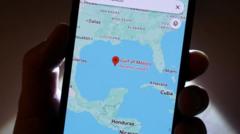In a significant diplomatic spat, Mexican President Claudia Sheinbaum has reached out to Google in a bid to maintain the name of the Gulf of Mexico amid changes proposed as a result of a recent U.S. executive order. The order, signed by former President Donald Trump during his early days in office, mandates a renaming of the Gulf to the Gulf of America, but only for users accessing Google Maps from the United States.
The Gulf, which is shared by Mexico, Cuba, and the U.S., has been known as the Gulf of Mexico for centuries. There is currently no global governing body responsible for the naming of maritime bodies, leading Mexico to contend that the name's alteration is unjustifiable under international law. "The U.S. cannot change the name of this body of water that everyone knows as the Gulf of Mexico," Sheinbaum stated, referencing the United Nations Convention on the Law of the Sea, which limits a country's claim over water to only 12 nautical miles offshore.
While Google has yet to officially respond to requests for clarification, the tech giant mentioned in a recent social media statement that they follow the practice of implementing changes based on official government sources when naming conventions shift. They also noted that when discrepancies exist in names across countries, users will see the official local name.
Seemingly unamused by the U.S. decree, Sheinbaum criticized the tech firm for acquiescing to a unilateral request from an individual nation regarding an international body of water. The president jested about other renaming proposals, suggesting that if the U.S. is making changes, Mexico could also look to have areas labeled “Mexican America” on maps. This comment underscores both the levity and seriousness of the underlying issue regarding sovereignty and international recognition.
This situation highlights ongoing tensions between Mexico and the U.S. regarding national identities and the influence of governmental policies on global perception. In light of this, it remains to be seen how Google will navigate this complex matter pertaining to geographic nomenclature and international diplomacy.
The Gulf, which is shared by Mexico, Cuba, and the U.S., has been known as the Gulf of Mexico for centuries. There is currently no global governing body responsible for the naming of maritime bodies, leading Mexico to contend that the name's alteration is unjustifiable under international law. "The U.S. cannot change the name of this body of water that everyone knows as the Gulf of Mexico," Sheinbaum stated, referencing the United Nations Convention on the Law of the Sea, which limits a country's claim over water to only 12 nautical miles offshore.
While Google has yet to officially respond to requests for clarification, the tech giant mentioned in a recent social media statement that they follow the practice of implementing changes based on official government sources when naming conventions shift. They also noted that when discrepancies exist in names across countries, users will see the official local name.
Seemingly unamused by the U.S. decree, Sheinbaum criticized the tech firm for acquiescing to a unilateral request from an individual nation regarding an international body of water. The president jested about other renaming proposals, suggesting that if the U.S. is making changes, Mexico could also look to have areas labeled “Mexican America” on maps. This comment underscores both the levity and seriousness of the underlying issue regarding sovereignty and international recognition.
This situation highlights ongoing tensions between Mexico and the U.S. regarding national identities and the influence of governmental policies on global perception. In light of this, it remains to be seen how Google will navigate this complex matter pertaining to geographic nomenclature and international diplomacy.




















